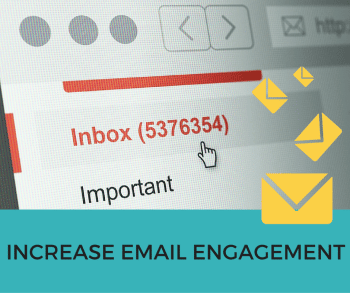Email marketing is one of the most critical channels available to your business. The ROI for email campaigns is 42:1, so clearly email marketing is a great way to drive sales. But your campaigns won’t succeed if your subscribers don’t find them compelling. That means your number one priority should be to increase email engagement.
The Benefits of Email Engagement
Also, consider this: when building a social media presence, you’re building an asset on someone else’s property, while your email list is yours.
Social media pages can be (rightly or wrongly) shut down, newsfeed algorithms change, and your target market’s social media platforms of choice will evolve. If you have built a strong email list, you’ll be able to engage those customers no matter what happens on Facebook, Google, or other platforms.
And engaged customers are more loyal, buy more, and are more likely to recommend you to their friends and family.
How to Increase Email Engagement
By increasing email engagement, you can improve customer loyalty, average order value, repeat purchases, and other vital metrics. To do that, you’ll need to focus on email acquisition and email engagement metrics to build your list and increase revenue. Here are seven ways to improve your email engagement strategy.
1. Use Lead Magnets to Learn More About Your Customers
Having a good lead magnet that provides highly valuable information or insights will help you get more people to subscribe to your newsletter. But it’s also a great way to get more information from the subscribers you already have.
You can get additional information every time someone converts by using progressive form fields or just switching the forms you select depending on the situation. This information will help you segment your audience better and deliver more personalized email campaigns.
2. Use Visitor Identification to Grow Your Audience and Learn More About Them
Knowing your audience is extremely important for driving engagement. Different types of audience segmentation, like demographic segmentation, can make this easier. Segmented email campaigns can lead to a 760% increase in revenue and keep unsubscription rates low by providing different groups with relevant content.
In addition to lead magnets, you can use visitor identification software to gather data about your subscribers and other website visitors. LeadPost is a visitor identification software tool that allows you to collect data such as:
- Phone number
- Email address
- Age
- Gender
- Location
- Income
- Homeownership status
- Education level
You can gather that data even if the visitor has never submitted a form on your website, so it’s also a great email acquisition tool.
Then, you can then use the information you receive to personalize email campaigns, group similar customers, and send relevant offers.
3. Write Engaging Subject Lines
Now that you have a mailing list, it’s time to look into ways to engage your subscribers efficiently. Your subject line is probably the most important element of your email.
It needs to be short (ideally less than 60 characters long), engaging, and sufficiently interesting or unusual, so your subscribers will open it.
But steer away from words and phrases like:
- “hurry”
- “don’t miss out”
- “sale”
(Don’t forget to A/B test your subject lines to see which ones get the best results.)
4. Keep Your Emails Short and Easy To Read
The average email length is 434.48 words. Just over fifty percent of emails have less than 300 words. Everyone is flooded with emails these days and most people don’t have time to read lengthy emails.
Keep the body of your emails short to increase readability. If people know your emails are brief and easy to read, they will be more likely to open them every time, especially if the content is interesting and actionable.
5. Use the Right Frequency and Timing
You don’t want to send emails too often, but you also don’t want your subscribers to forget you.
Regular emails are your best bet; you need to establish the right frequency for your industry and business by looking at your email engagement stats over time. Keep your subscribers up-to-date about new blog posts, products, or upcoming sales.
The time at which you send your emails is also important. While it will depend on your business, conventional wisdom says the best days to send emails are Monday, Tuesday, and Wednesday, usually between 9-11am and 1-3pm.
However, you’ll need to find the sweet spot for your business by experimenting with different email campaigns and see what works best for you. For this, you can use A/B testing, analyze open rates, and see what your competitors are doing.
6. Create a Sense of Urgency
Creating a sense of urgency or scarcity (or both) will increase click-through rates.
You can do this with limited-time offers, discounts for finalizing an order if it has been abandoned, and even sending happy birthday greetings with a personalized gift voucher that has to be used soon.
7. Build a Connection with the Help of Personalized Content
Nowadays customers expect companies to adapt to their interests, purchasing history, and feedback. That’s why emotion-driven engagement and personalization are so critical.
Businesses that invest in meaningful personalization strategies and use the right audience segmentation tools will reap the rewards of customer engagement. They will build a reputation for trustworthiness, integrity, and honesty. That will turn their customers into devotees.
Improve Email Engagement
You can easily see whether your email engagement strategy is working by measuring your subscribers’ activity and looking into your stats for each campaign, such as clickthrough and open rates, unsubscribe rates, conversion rates, and more.
If your email engagement metrics are suffering, these tips will help you get things back on the right track. If you need more help, check out our guide on how to write a marketing email.
That article will cover everything you need to know to write compelling emails that drive your subscribers to act.
